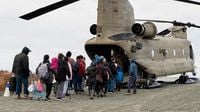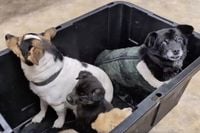In the wake of Typhoon Halong’s destructive sweep across Alaska’s western coastline, a scene of chaos and resilience has unfolded. Villages along the Bering Sea, battered by storm surges and winds reaching 100 mph, have witnessed not just the largest human airlift in the state’s history, but also a parallel rescue effort—one aimed at saving the four-legged companions left behind in the rush to safety.
On October 17, 2025, as reported by ABC News, the remnants of Typhoon Halong brought catastrophic flooding to at least 11 small rural communities in Alaska. The storm’s impact was swift and severe: at least one person in Kwigillingok was confirmed dead, two others went missing when their house was swept away, and hundreds of homes suffered damage so extensive that many may remain uninhabitable through the coming winter. State officials, facing both the immediate threat and the looming onset of freezing temperatures, began airlifting more than 1,000 residents from these remote villages to larger cities like Anchorage.
Yet, as the military and emergency personnel focused on evacuating people, a quieter crisis emerged. Pets—mostly dogs—were not permitted on the evacuation flights. In these isolated communities, where boats and planes are the only means of travel and roads are nonexistent, the prospect of leaving behind beloved animals was heartbreaking for many families. That’s where Bethel Friends of Canines, a local nonprofit, stepped in.
According to the Associated Press, Bethel Friends of Canines learned that between 50 and 100 dogs might be stranded in the village of Kipnuk alone. The group’s organizer, Jesslyn Elliott, described the urgency and uncertainty of their mission: “It costs us $3,000 to do this so and we don’t know how many times we’re gonna have to do it. We’ve never had a natural disaster to this, like, magnitude. So this is all very, very foreign and new to us. So we’re just kind of winging it.”
The first dog evacuation flight arrived in Bethel on the night of October 15, 2025, with subsequent flights taking place in the days that followed. The operation was no small feat—dogs arrived in plastic storage boxes, sometimes in groups as large as 15 on a single flight. Each animal’s journey was harrowing. Veterinarian Susan Shaffer Sookram greeted one group of arrivals with a relieved, “What a scary ride! You made it!”
Behind these efforts was a groundswell of community support. The nonprofit raised over $22,000 after a plea for donations on Facebook, a testament to the region’s compassion. Volunteers, including teachers who stayed behind in Kipnuk as some of the last residents, played a crucial role. Jacqui Lang, a teacher, found a dog named Happy waiting on its owner’s clothes, refusing to move or eat. Thanks to the coordinated effort, Happy and at least eight other dogs were reunited with their families in Anchorage by October 16, 2025.
“You’ve got some heroes out in Kipnuk. They’re like the last people left there,” said Matthew Morgan, a Bethel Friends of Canines worker. “Without them, it would have been chasing dogs all night in the mud.” These teachers, alongside nonprofit staff, coaxed frightened dogs into crates, labeled them with their owners’ names, and helped load them onto the small planes that would carry them to safety.
As for the human evacuation, the scale was unprecedented. ABC News confirmed that the airlift, described as the largest in Alaska’s history, was launched to move hundreds of residents from communities like Kipnuk and Kwigillingok after local leaders requested immediate evacuation. The priority, according to state officials, was clear: “The evacuation of people is the priority.” With winter weather fast approaching—rain and snow were forecast for the weekend—there was little time to spare.
Homes in the affected villages, many of which are only accessible by air or water, were so badly damaged that repairs may not be possible until the following summer. Emergency management officials warned that with the human population shrinking each day, the window for rescuing pets was closing rapidly. “There’s going to be nobody left there,” said Sookram. “We’re having to kind of accelerate how the animals are going to be leaving places only accessible by, at first, helicopter and now small planes.”
The logistical challenges were daunting. Bethel, a regional hub about 90 miles away by boat or plane, became the staging ground for both human and animal evacuees. Before the flooding, Bethel Friends of Canines typically housed just 15 to 20 dogs at a time; now, dozens passed through their kennels in a matter of days. Many pet owners, forced to flee without their animals, hoped for a reunion once they secured temporary housing in cities like Anchorage and Nome, over 250 miles away.
Throughout the ordeal, schools in the flooded towns became emergency shelters and meeting places, providing refuge for both people and pets during the initial relief effort. Teachers, already pillars of their communities, became instrumental in the animal rescue operation as well.
While the focus remained on saving lives, the story of the dog airlift resonated well beyond Alaska. It became a symbol of the extraordinary lengths to which communities will go to protect all their members—human and animal alike—in times of crisis. The images of dogs being released from crates in Bethel, tails wagging after a terrifying journey, captured the spirit of hope and resilience that defined the response to this disaster.
As the floodwaters recede and the long process of recovery begins, the people of Alaska—and their pets—face an uncertain winter. But the bonds forged in the midst of disaster, and the acts of kindness that carried both people and animals to safety, offer a glimmer of warmth against the coming cold.






